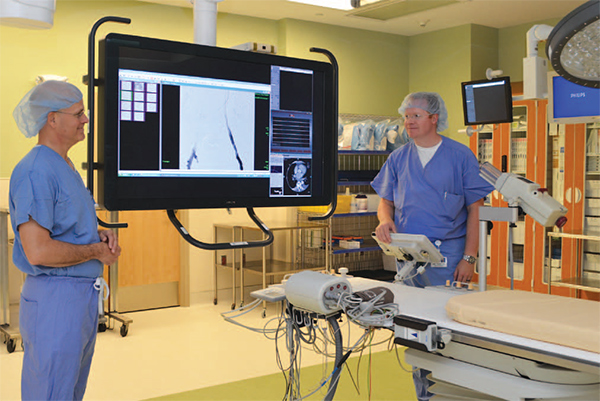McLaren Bay Region's $3.5 million investment in a Hybrid Operating Room with state-of-the-art imaging allows for less invasive, less traumatic procedures for increasingly complex vascular treatment. McLaren Bay Region is the only hospital in the Great Lakes Bay Region to offer this new equipment.
The Hybrid Room, nearly twice the size of a traditional operating room, combines highresolution ultrasound and X-ray imaging capabilities with a clean operating theater, including capability for general anesthesia and heart bypass, if needed. There, specialists can perform catheter-based procedures that are minimally invasive, traditional "open" surgical procedures, or a combination of both, with lower risk for patients.
 Vascular surgeons Dr. Stephens Taylor, left, and Dr. Axel Thors in the new Hybrid Operating Room at McLaren Bay Region.
Vascular surgeons Dr. Stephens Taylor, left, and Dr. Axel Thors in the new Hybrid Operating Room at McLaren Bay Region. Exceptional Imaging for Complex Procedures
According to Stephens Taylor, M.D., a vascular surgeon with McLaren Bay Heart & Vascular, the Hybrid Room's technology allows a degree of certainty of which vessel needs treatment that previously was available to only a handful of health systems across the country.
"The Hybrid Room really takes McLaren to the next level," says Axel Thors, D.O., the newest vascular surgeon to join McLaren Bay Region. "With 14 percent of adults in the area having some degree of heart and vascular disease, the need for this type of imaging capability to support evermore complex procedures available to manage these patients is a clear example of McLaren Bay Region's dedication to its mission of caring for people in the Great Lakes Bay Region."
Willa Rousseau, director of Patient Care Services of Cardiology, adds, "The Hybrid Room's combined setting, which offers exceptional imaging capabilities during surgical procedures, reduces delays and infection risk associated with having to move patients to different areas of the hospital."
And Linda Szafranski, director of Patient Care Services of Surgery, notes that better imaging means that more procedures can be done on a less invasive basis, with less need for general anesthesia for most patients.